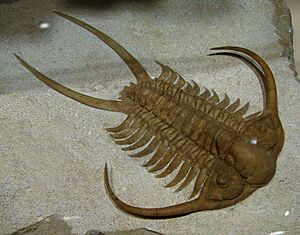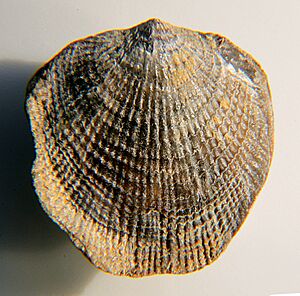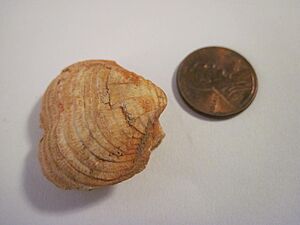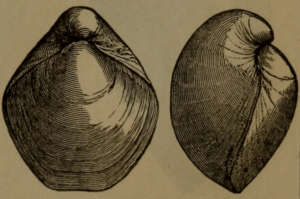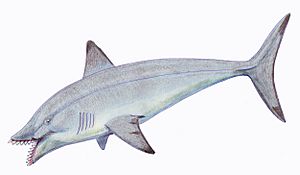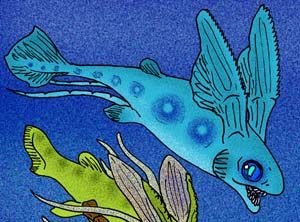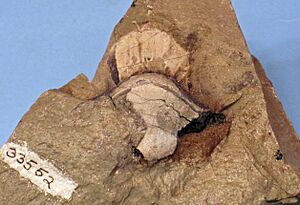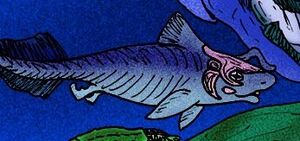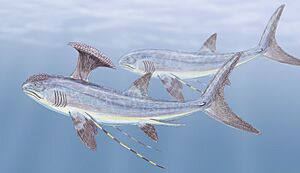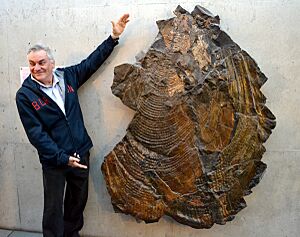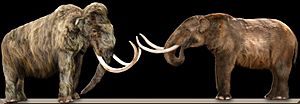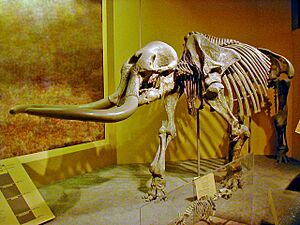List of the prehistoric life of Iowa facts for kids
This article is about the amazing ancient life whose fossils have been found in Iowa, a state in the United States. These fossils tell us about creatures that lived long, long ago, even before humans existed! Iowa was once covered by ancient seas, and later, it was home to giant ice age animals. Let's explore the prehistoric creatures that once called Iowa home.
Contents
Ancient Eras and Their Life
Precambrian Era: Earth's Earliest Life
The Precambrian Era was a super long time ago, billions of years before dinosaurs! During this time, Earth was just forming, and the very first simple life forms appeared, like tiny bacteria. So far, scientists haven't found any fossils from the Precambrian Era in Iowa. This means that either the rocks from that time aren't exposed, or any tiny life forms didn't leave behind clear fossils.
Paleozoic Era: Life in Ancient Seas
The Paleozoic Era began about 541 million years ago and ended around 252 million years ago. During much of this time, Iowa was covered by warm, shallow seas. This is why many of the fossils found in Iowa from this era are of sea creatures! Imagine a time when Iowa was like a giant ocean aquarium.
Here are some cool creatures that lived in Iowa's ancient seas:
- Trilobites: These were ancient sea bugs, a bit like modern crabs or lobsters, but they are now extinct. They had segmented bodies and hard shells.
- Brachiopods: These creatures look a bit like clams, but they are different. They lived inside two shells and were very common in the ancient oceans.
- Crinoids: Often called "sea lilies," these animals looked like plants but were actually related to starfish and sea urchins. They had a stem that attached them to the seafloor and feathery arms to filter food.
- Ancient Fish: Some very early fish also swam in Iowa's waters. These included strange-looking sharks and lobe-finned fish.
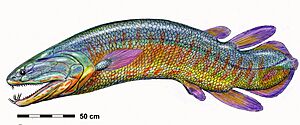
Some other interesting creatures from the Paleozoic Era found in Iowa include:
- Acidaspis
- Amplexus
- Bellerophon
- Bumastus
- Calymene
- Cardiola
- Catenipora
- Ceratocephala
- Ceraurus
- Chomatodus
- Chonetes
- Cleiothyridina
- Climacograptus
- Coenites
- Conocardium
- Crania
- Crotalocrinites
- Cyathocrinites
- Cyclonema
- Cyphaspis
- Cypricardinia
- Cyrtolites
- Cystodictya
- Dalmanites
- Decadocrinus
- Deiphon
- Deltaherpeton
- Dentalium
- Dicoelosia
- Dimerocrinites
- Diplograptus
- Discosorus
- Earlandia
- Edmondia
- Eldredgeops
- Ellesmeroceras
- Encrinurus
- Endoceras
- Eocaudina
- Eodictyonella
- Eophacops
- Eospirifer
- Eucalyptocrinites
- Euomphalus
- Favosites
- Fenestella
- Flexicalymene
- Goniatites
- Gravicalymene
- Greenops
- Grewingkia
- Gyroceras
- Hallopora
- Halysites
- Harpidium
- Heliophyllum
- Hexagonaria
- Hindia
- Holopea
- Huronia
- Hyolithes
- Icriodus
- Idiognathodus
- Iocrinus
- Isotelus
- Kayoceras
- Kionoceras
- Krausella
- Leptopora
- Lingula
- Manticoceras
- Marsupiocrinus
- Meristina
- Michelia
- Michelinoceras
- Murchisonia
- Mycterops
- Mystrocephala
- Naticopsis
- Neospirifer
- Nucula
- Odontopleura
- Orthoceras
- Oulodus
- Ozarkodina
- Pachyphyllum
- Paladin
- Palmatolepis
- Peachocaris
- Pentamerus
- Pentremites
- Periechocrinus
- Phacops
- Phillipsia
- Pinnocaris
- Plaesiomys
- Platyceras
- Platycrinites
- Platystrophia
- Plectodonta
- Pleurocystites
- Pleurotomaria
- Plicochonetes
- Poleumita
- Polygnathus
- Posidonia
- Proetus
- Rhynchodus
- Rigidella
- Scutellum
- Scytalocrinus
- Septemchiton
- Sigournea
- Similodonta
- Skenidioides
- Sowerbyella
- Sphenothallus
- Spirifer
- Spiriferina
- Spirorbis
- Spyroceras
- Streptognathodus
- Strophomena
- Stylonema
- Syringopora
- Taxocrinus
- Tranodis
- Whatcheeria
- Worthenia
- Youngia
Mesozoic Era: Age of Dinosaurs (and More!)
The Mesozoic Era, often called the "Age of Dinosaurs," lasted from about 252 to 66 million years ago. While dinosaurs roamed the land, Iowa was still partly covered by seas, especially during the Cretaceous Period. This means that most Mesozoic fossils in Iowa are from marine life or ancient plants.
Here are some fossils found from this era:
- Giant Clams: One of the most impressive marine fossils found in Iowa is Inoceramus. These were huge clams that could grow to be several feet across!
- Ammonites: These were shelled creatures related to modern-day squid and octopuses. They had coiled shells and were common in the ancient seas.
- Ancient Plants: Fossils of ancient plants, including spores and seeds, have also been found, showing what the plant life was like.
Some other interesting fossils from the Mesozoic Era found in Iowa include:
- Arcellites
- Balmeisporites
- Chrysotheca
- Coptothyris
- Dunveganoceras
- Metengonoceras
- Microcarpolithes
- Minerisporites
- Molaspora
- Perotrilites
- Pilularia
- Regnellidium
- Spermatites
Cenozoic Era: Rise of Mammals and the Ice Age
The Cenozoic Era began about 66 million years ago and continues to the present day. This is the "Age of Mammals." During this era, Iowa experienced several ice ages, where huge glaciers covered much of the land. These glaciers shaped Iowa's landscape and left behind fossils of large mammals that lived in colder climates.
Here are some of the fascinating Cenozoic animals found in Iowa:
- Mammoths and Mastodons: These were giant, elephant-like creatures that roamed Iowa during the Ice Age. Mammoths had long, curved tusks and were covered in woolly hair. Mastodons were a bit smaller and had straighter tusks.
- Giant Ground Sloths: Imagine a sloth the size of a car! These massive, slow-moving creatures lived in Iowa.
- Ancient Camels: Yes, camels once lived in Iowa! They were different from the camels we see today, but they were part of the diverse mammal life.
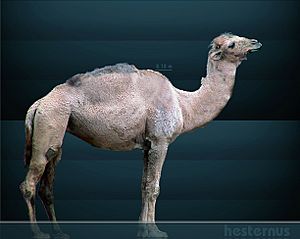
- Other Mammals: Fossils of ancient horses, beavers, deer, and even large cats like saber-toothed cats have been found, showing a rich variety of wildlife.
Some other interesting fossils from the Cenozoic Era found in Iowa include:


